Japanese Knotweed (Fallopia japonica) Identification and Removal
The Japanese knotweed (Fallopia japonica) originated from Japan and was brought to the UK as an ornamental plant in the nineteenth century, it’s now considered as a invasive weed. Knotweed spreads quickly. In winter, plants die, but by early summer can shoot bamboo-like stems more than 2.1 meters (7ft) in height, suppressing all other plant growth. You need to be determined and persistent in order to eradicate it by hand or using chemicals.
Japanese Knotweed (Fallopia japonica)- what is it?
It is a vigorous perennial with tall, dense stems that form clumps fast. The underground roots (underground rhizomes) that penetrate deeply renew stem growth every year, which dies back over winter. The Japanese knotweed plant is not native to Britain and this page describes how it can be controlled, despite originally being introduced as an ornamental gardening plant.
Think of it as a giant Daffodil or Canna Lily, both of which are bulb plants, they regrow every year and then die back.
Japanese Knotweed Identification: How To Identify it?
From the ground, crimson-pink buds form dark reddish-purple shoots in the spring. Growing rapidly, they produce dense stands of bamboo-like canes sprouting from the rhizome that reach a height of 2.1 m (7 ft) in the summer. Purple flecks or purple speckles adorn these canes, and branches grow from their nodes along their length.
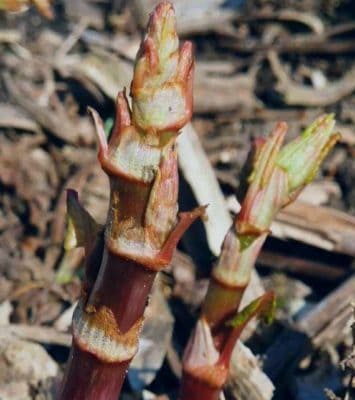

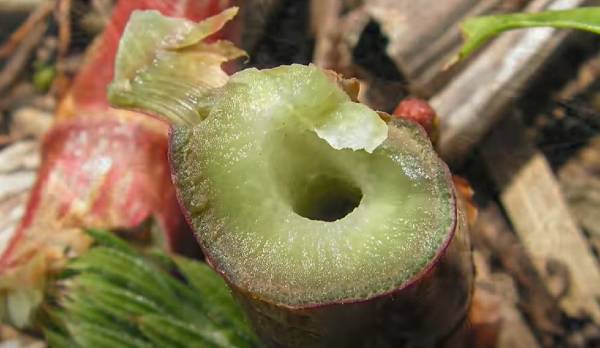

It has a heart or shovel leaf shape which grow up to 14cm (5 and a half inches) long in alternate rows along the stems (in a zigzag pattern). Late summer and early autumn bring creamy-white flower tassels that can reach 15cm (6in). It dies back to the ground in the winter, but the dry canes remain for many months.
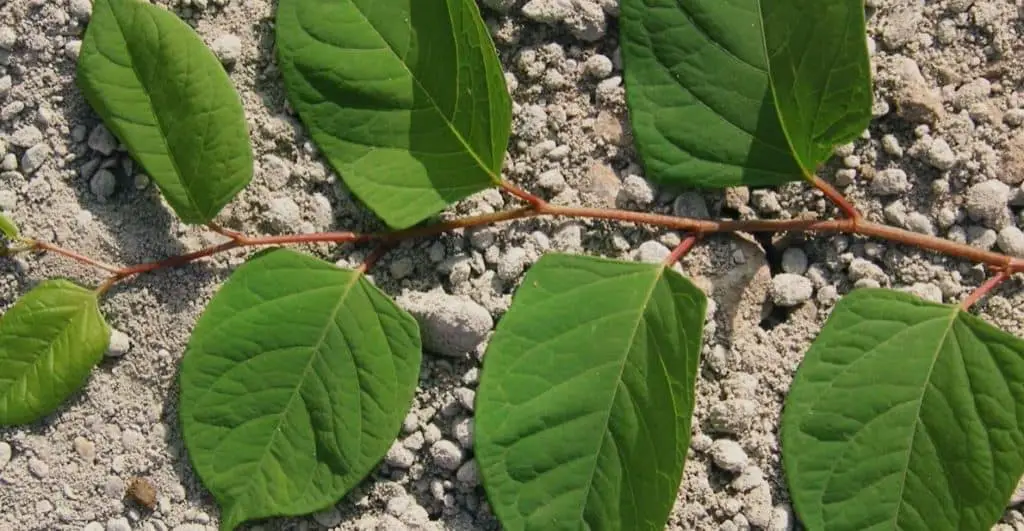
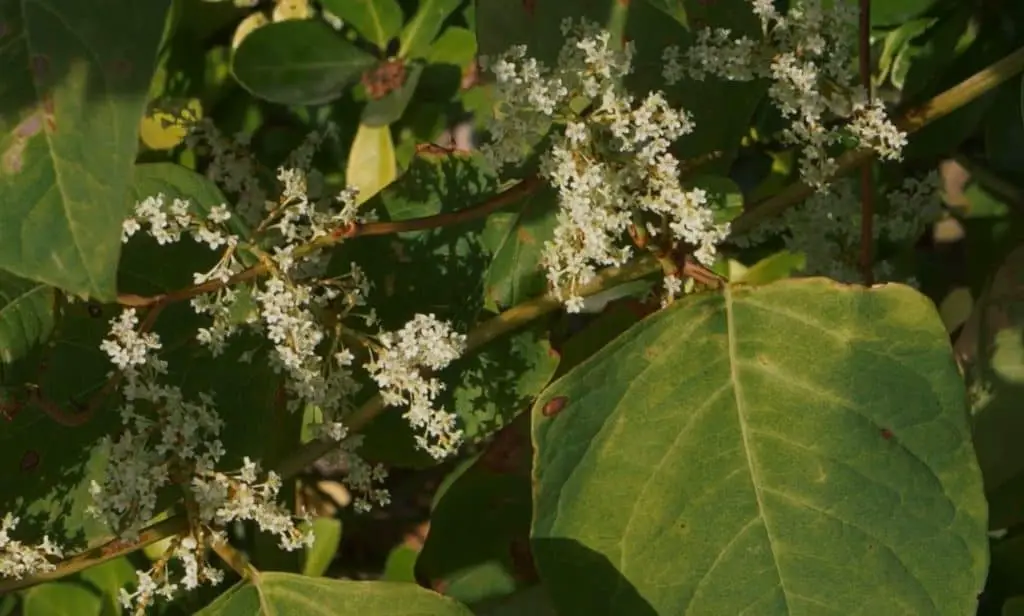
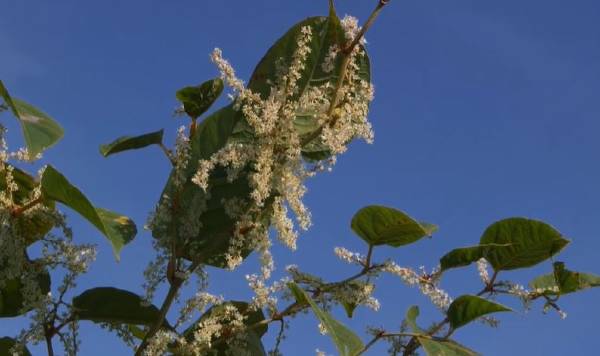
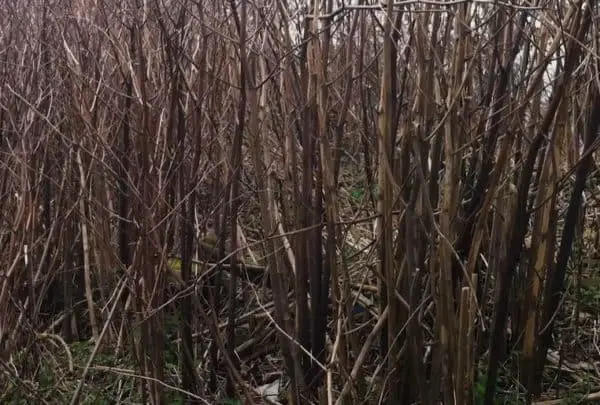
The importance of Japanese Knotweed identification cannot be overstated. There are a number of plants that can be confused with Japanese knotweed, including:
Among the most common are Fallopia baldschuanica (Russian vine), Leycesteria formosa (Himalayan honeysuckle), Houttuynia cordata, and Persicaria microcephala.
Why Is Japanese Knotweed A Problem?
According to the International Union For Conservation of Nature, this plant is currently on their list of the world’s worst invasive species. Depending on the soil condition and weather, roots of this invasive species can grow underground for up to seven meters.
The rapid growth and invasive nature of Japanese knotweed can make it troublesome in urban and rural areas alike. Plants like this cause damage to urban environments such as gardens and road verges, as they grow up through tarmac and paving, out-competing other species and destroying garden landscapes as well as causing structural problems, such as when they grow into walls and cracks.
Many of us have heard horror stories about Japanese knotweed plant growing through driveways and causing structural damage; however, recent research published in 2018 suggests Knotweed may not be as harmful as other trees or plants that do not have the same controls.
Normally Japanese knotweed does not set seeds in the United Kingdom, except by hybridizing with other species of knotweed. One study showed that 0.7 grams of rhizome material, the size of a little finger nail, could produce a new plant in as little as 10 days.
In accordance with Schedule 9 of the Wildlife and Countryside Act 1981, to cause Japanese knotweed to grow in the wild constitutes an offence.
You can report fly tipping to the Environmental Agency on 0800 807060.
The Legal Situation With Japanese Knotweed
As of 2013, property buyers and sellers have been required to state whether Japanese knotweed (Fallopia japonica) resides on the property by way of a TA6 form – the property information form that is required for conveyancing. Legal advice can be obtained from your conveyancer or solicitor, but the following points summarize the process:
- As the seller (property owner), your responsibility is to check for Japanese knotweed in the garden (keeping in mind that it can die back over the winter) and stopping it from spreading to neighbouring property.. On the TA6, you are required to indicate whether your property is afflicted with Japanese knotweed and, if so, to provide details of a specific management plan for its removal from a professional company (see Getting help from the pros below).
- The presence of Japanese knotweed will be indicated on the TA6 form if you are purchasing. The mortgage lender usually will need assurances that the problem will be solved before agreeing to the funds. Professional eradication companies usually provide management plans that are backed by transferrable guarantees. It is not uncommon for the seller to provide this plan before the purchase is finalized
- It is also important to be proactive when buying or selling properties by checking for Japanese knotweed. This approach will help avoid problems such as delays, increased costs, and a possible misrepresentation claim after the sale, caused by misunderstandings over the identity of a plant or its presence.
In an amendment to the Anti-social Behaviour, Crime and Policing Act 2014, Japanese knotweed is included as an invasive non-native plant. What this means to the homeowner is as follows:
- Although it is not illegal to have Japanese knotweed in your garden, you ought to try to keep this non-native plant under control on your property so that it does not spread into your community. The legislation could be used to enforce its control, and property owners could be prosecuted if it has continued or persistent impacts on quality of life for those in the locality
- Japanese knotweed often grows in neighbouring gardens, so we recommend speaking or communicating directly with your neighbours (who, in some cases, are already taking steps to control this weed). Prior to contacting your council for action under the legislation, you should first follow these informal steps
- In cases where a clump is small and isolated, a homeowner can attempt to control it themselves. Specialist Knotweed removal companies will be able to control, ensure eradication, and dispose of Japanese Knotweed waste at a licensed landfill site.
Japanese knotweed is categorized as ‘controlled waste’ under the Environmental Protection Act 1990. In other words, it’s illegal to add it to your garden waste bin or compost bin. The waste can be burned (ideally after it has dried). A licensed landfill site is where you can dispose of it instead.
Japanese Knotweed Removal and How To Control It.
Well there are 2 options:
Option 1: Get a professional Japanese Knotweed Removal company in to deal with it.
How much will it cost to get Japanese Knotweed Removed?
Japanese Knotweed Removal cost will vary depending on various factors such as: the size of the area, the method of Japanese Knotweed treatment being used to tackle the problem and the company being used.
| Size Of Infestation | Small (<50m2) | Medium (50m2 - 100m2 | Large (100m2 - 500m2 |
| Herbicide Treatment | £2000 - £3000 | £3000 - £5000 | Large (100m2 - 500m2 |
| Reduced Dig and Root Barriers | £2000 - £5000 | £5000 - £10000 | Large (100m2 - 500m2 |
| Pick and Sort / Screening | £2000 - £5000 | £5000 - £10000 | Large (100m2 - 500m2 |
| Onsite Relocation and Herbicide | £5000 - £10000 | £8000 - £15000 | Large (100m2 - 500m2 |
| Burial On Site | £5000 - £15000 | £12500 - £20000 | Large (100m2 - 500m2 |
| Full Excavation and Disposal | £5000 - £20000 | £15000 - £40000 | Large (100m2 - 500m2 |
Please note that the above figures are average prices.
If your looking for approved specialist contractors you can visit the PCA (Property Care Association) or the INNSA (Invasive Non-native Specialists Association) trade body for approved contractors. It’s also the only way to get a Knotweed Management Plan if your trying to sell your home.
Chemical control with herbicides
Herbicides are applied to Japanese knotweed plants over the course of several growing seasons as a form of chemical control. In most cases, this is the least disruptive and most cost-effective option. Particularly so in a residential environment, where space is scarce and property boundaries are close together. In terms of practicality, cost, and the requirement to satisfy lenders, managed chemical control can often be the only option in most cases. You can cut and burn the plants once they are dead. It is a good idea not to remove burned materials from the site due to contamination risks.
The excavation of the roots and the plant
Infested soil can be excavated and disposed of at a waste-management facility, off-site, as long as it is appropriately licensed. Excavating soil is a difficult and time consuming task with varying volumes from site to site.
Burying and / or encapsulating roots on-site with membranes
It is possible to dig up and bury Japanese knotweed on-site, but the root system needs to be covered by a root barrier membrane in order to prevent regrowth. Japanese knotweed can also be encapsulated by a root barrier membrane if space doesn’t permit burial.
Option 2: Get Rid Of It Yourself – Several Ways To Do This
You actually can get rid of Japanese Knotweed by yourself and you don’t have to call in a specialist company if you don’t want to. Just be prepared that the complete elimination of Japanese Knotweed could take you a few years.
The whole idea is that If you don’t manage to get it all the first year, then you want to cause it as much stress as possible, killing off as much of the Rhizome as possible.
So before you get started you will need a few items to help make life easier for yourself, you may not need all of these items, what you need will depend on which method you choose to tackle the Japanese Knotweed.
- Weed Killer containing Glyphosate 360g per litre such as GALLUP HOME & GARDEN WEED CONTROL
- Safety Gear for handling weed killer, including googles and gloves
- Weed Killer Sprayer
- Tarpaulin
- Saw
- Garden Riddle
- Small Garden Trowel
- Garden Incinerator (It is illegal to dispose of Japanese Knotweed with your household waste or if you have one a council garden waste bin).
- A sharp poking implement like a long screwdriver or long metal BBQ skewer
- Funnel
- Garden Shears
- Stem Injector Kit
Method One – Weed Killer with a Sprayer or Steam Injector (Herbicide Treatment)
This is the easiest method out of all the mentioned methods, you just simply prepare your weed killer and spray the Knotweed remember to spay the underside as well as the upper surface of the leaves. Wait a month and then re-treat it again the same way. Once the stems have died remove them and allow them to dry out, then burn them in a garden incinerator.
If the Knotweed is growing amongst or near wanted plants then you can use a stem injector kit. Fill a stem injector kit with your weed killer put on your safety gear and then inject the Japanese Knotweed below the lowest nodal point, give it a couple of squirts and your good to go. This allows the weed killer will to go straight into the root system. After a couple of weeks you can just use a pair of garden shears to remove the stems and then burn them in a garden incinerator.
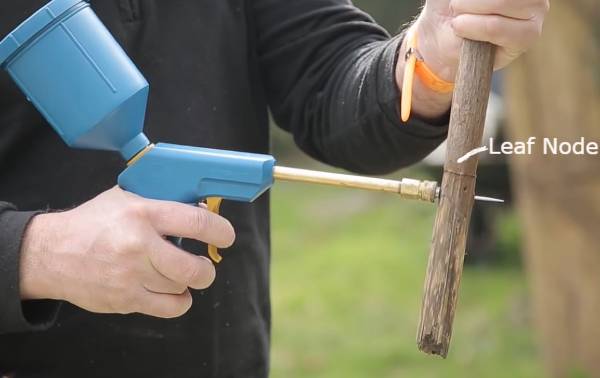
The best time to apply the weed killer is when the plant starts flowering usually early late spring early August. Weed killer must be applied before it naturally dies back in Autumn.
With this method it can take a couple of years to completely eradicate Japanese Knotweed.
Method Two – Cut and Pour
Grab your garden shears and cut the stems as low to the ground as possible, next you want to use a sharp poking implement and poke it down the hollow stem to help open up the passage into the root system. Get the funnel and place it into the hollow stem and then just pour your Glyphosate weed killer neat without dillution straight into the root system. Repeat this with all the stems.
Remember to dispose of the cut stems by allowing them to dry out and then burning them in a garden incinerator.
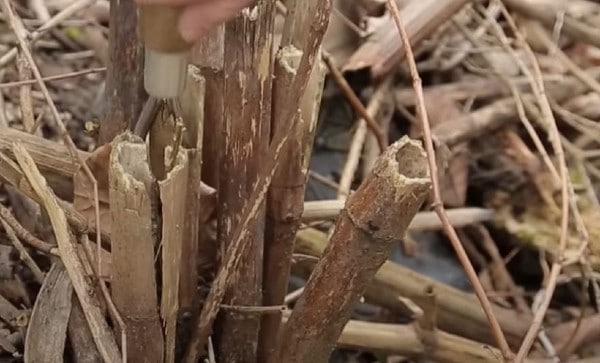
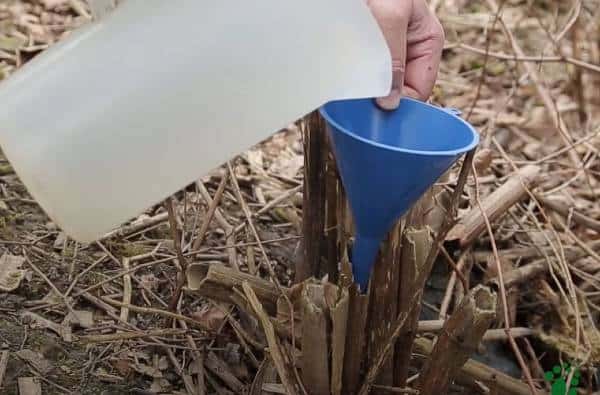
Method Three – Dig It Up
If you have a large patch them we don’t recommend using this method due to how much effort it requires.
- Cut the stems down to the ground as low as possible, then remove them to somewhere that they can dry out before disposing of them by burning them.
- Open the tarpaulin up near to where the root system is on the ground.
- Carefully start clearing away the soil from around the root system.
- As you remove the soil from around the rhizome (root) , put that soil through a garden riddle. Do this whilst holding the garden riddle above one half of the tarpaulin, remove any woody or root type material that you find and put that on the other half of the tarpaulin.
- Keep going until you can remove the whole root system (rhizome).
- Place the Japanese Knotweed rhizome on the half of the tarpaulin that has the woody bits.
- Now remove an extra 20cm worth of soil from all around the hole and run it through the garden riddle. You want to make sure that you have removed it all and no bits have broken off. Japanese knotweed will regrow from the tiniest of fragments left behind.
- Now remove the root and woody pieces from the tarpaulin to somewhere it can dry out for several days (you can line the bottom of your garden incinerator with newspaper to stop any bits falling out and then place the root and woody bits in it to dry out). You now need to allow the root system and all the woody pieces removed to dry out before burning it, the dryer it is, the less chance of it surviving being burnt. There have been cases where Japanese Knotweed has regrown from being burnt.
- If the root system you removed is quite large then you can use a pruning saw to cut it half over the tarpaulin before you remove everything as mentioned above.
- Spread out the soil that was on half the tarpaulin over the whole tarpaulin and let it dry out for a couple of hours. Then spray all the soil on the tarp with weed killer, again wait a couple more hours. Now you can place the soil back, refilling the hole.
- Once dried out use can burn all the Japanese Knotweed, however it’s best if you can gather more garden waste material to burn along with it. Why? because this helps to keep the fire burning for longer ensuring that all the Japanese Knotweed is in fact destroyed.
Things to look out for
Knotweed in spring that’s been treated with glyphosate often produces small leaves and bushy regrowth (a dense clump) the following spring, which can reach 50-90cm (20in-3ft) in height. Compared to the normal plant, the regrowth is noticeably different, and it is imperative that it be treated again as soon as possible.
If you decide to handle Japanese knotweed yourself, you will not receive an insurance-backed treatment plan guarantee. This may be important if you are looking to sell your property soon or if you are being threatened with legal action by a neighbour because they have observed knotweed growing.
Japanese Knotweed The Other Side Of It
It’s not all doom and gloom with Japanese Knotweed as everyone makes it out to be, believe it or not, it’s not a problem in it’s native in Japan. This is due to insects that target it their which we don’t have here in the UK.
Did you know that the root shoots of the plant are edible? That’s right you can eat them, apparently they taste a bit like rhubarb, It can be found in Supermarkets all over Japan when in season.
A research paper published on Frontiers In Medicine has shown that Japanese Knotweed is effective in the treatment of Lyme Disease. It’s also jammed packed with Resveratrol, which has been used in Japanese and Chinese herbal medicine for centuries.
